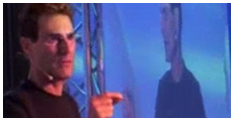Secrets of the military’s investigations into ESP revealed!
There’s been a story in my family for years that flirts with the paranormal. It dates back to the early 1960s, before I was born. My father was driving along a highway near Los Angeles, and the road, as he describes it, was ramrod straight for miles before it took a sharp and unexpected left turn. My father recounts that just as he applied the brakes and downshifted into the bend, the car suddenly filled with the unmistakable scent of his mother’s perfume. By the time he completed the turn, the smell was gone.
When he mentioned the episode to my aunt months later, the color drained from her face. She asked my father to describe precisely where he had been and then declared that it was the exact spot where my grandmother had died in a car accident years before.
I was a child when my father told the story, and it was my first brush with what might be called some sort of extrasensory perception. Was my departed grandmother sending a small message, or was this unusual turn in the road simply sparking a repressed memory of a story told long ago?
I wouldn’t say that I embraced my father’s version of events exactly, but clearly it made an impression, as I remember it all these years later.
Those are the kinds of slightly unsettling stories that drive the narrative in Annie Jacobsen’s new book, “Phenomena: The Secret History of the U.S. Government’s Investigations Into Extrasensory Perception and Psychokinesis.” It’s an entertaining narrative about the U.S. government’s forays into psychic phenomena that, in Jacobsen’s telling, seem only slightly more scientific than my father’s experience in Los Angeles.
There are two kinds of people who read books like this: the ones who already believe and are looking for affirmation, and those in my camp, skeptics looking (and failing) to find proof.
The usual suspects of the paranormal all make cameo appearances in the book: from ESP and clairvoyance to out-of-body experiences, telepathy and spoon bending. The difference is that this time, the suspects are sometimes in uniform.
Jacobsen begins with a man named Andrija Puharich, who, after going to medical school, persuaded a roster of rich people — from Astors to du Ponts — to fund his experiments in extrasensory perception. They established a research laboratory in Maine called the Round Table Foundation, where Puharich promised to prove once and for all that we all possess an untapped potential beyond our five senses.
As fate would have it, Camden, Maine, was (and still is) a favored retreat not just for East Coast aristocracy but for the intelligence community as well, and it was there that Puharich began his on-again, off-again relationship with the U.S. government. At parties in seaside mansions, Puharich met key leaders in the military who ended up funding his experiments. He was asked, among other things, to investigate ESP and see whether it could be used as a means of long-distance communication in submarines, and to explore the potential “for psychic healing on the battlefield.”
“U.S. government military efforts to explore psychic phenomena remained mostly out of the public eye until December 1959,” Jacobsen writes, “when an article about a secret government ESP program appeared in a French magazine called Constellation. . . . [The article] reported that ESP tests had been conducted aboard the world’s first nuclear-powered submarine, the USS Nautilus, the year before.”
The French journalist reported that a sailor aboard the Nautilus had been isolated inside a cabin under the sea and had been asked to connect with a technician on the East Coast of the United States. The civilian scientist helping with the experiments told the magazine that “about 75% of the telepathic tries are said to have been successful” (a contention the Navy later denied — officials said the story was a hoax). Even so, the Soviets and the Chinese took notice, and an undeclared ESP war began.
For skeptics, Jacobsen’s meticulous reporting on the government’s experiments into the paranormal won’t prove to be very satisfying. She describes how psychics were tested by believers, who ended up giving new meaning to the idea of confirmation bias. (The contention was that nonbelievers would skew results with their negative energy.) Time and again, experiments were presented to military and intelligence officials as earth-shattering, but without peer review or meaningful attempts to re-create the supposed breakthroughs, they tended to disappear into the ether.
Among the characters with whom Puharich became obsessed was an Israeli named Uri Geller. For readers who watched variety shows in the 1970s, you may remember Geller as the guy who bent spoons on camera with his mind. He would do so by placing two fingers near his neck, concentrating hard and saying, “Bend, bend, bend.” He asked the viewing audience to try it for themselves at home.
His party trick went to the next level when he was giving a telepathy demonstration in a theater in Tel Aviv and said he needed to sit down. He claimed he was woozy because a historical event was about to happen or had just occurred. “Geller claimed that Gamal Abdel Nasser, the president of Egypt — Israel’s sworn enemy at the time, ‘had just died or is about to die.’ ”
“Twenty minutes had passed when someone ran into the room shouting,” Jacobsen writes. “Radio Cairo had just announced that Present Nasser was dead. At 6:00 that evening, he had suffered a heart attack and died. With this news, Uri Geller’s reputation skyrocketed.”
Not long after, Puharich arrived in Israel and asked Geller to come to his lab for testing.
“Phenomena” is about the U.S. government’s efforts to understand people like Geller — Jacobsen makes clear that some were sympathetic figures and others were clearly charlatans.
For much of the book, Jacobsen seems firmly ensconced in the skeptics camp, but in the final chapters she seems to succumb to her own evidence. One of her most convincing examples involves a clandestine unit in Army intelligence known as Detachment G, or Det G.
Weary of having to decide whether the people who claimed to have special mental powers were taking officials for a ride, the Army dipped into its own ranks to find soldiers who appeared to have some extrasensory gifts.
In September 1979, after satellite images suggested increased activity inside a massive building at Severodvinsk Naval Base in Russia, about 650 miles north of Moscow near the Arctic Circle, the National Security Council called upon these psychic soldiers. The council wanted Det G to use its “remote viewing” powers to figure out what was inside the building.
The military turned to a man named Joe McMoneagle. He was asked to concentrate on a photograph concealed in an envelope, and he immediately described seeing a building near a shoreline. He said that it smelled like gas and that there was some kind of vessel inside. “I’m seeing fins,” he said, “but they’re not rocket fins or [air]plane fins. They’re . . . they look like shark fins.”
Four months later, Jacobsen writes, new satellite images “made clear to the CIA that the Soviets had covertly constructed a prototype for an entirely new generation of nuclear-powered ballistic missile submarines. The Soviets called this clandestine effort Project 941, codename . . . ‘Shark’ in Russian. The Shark submarine would become known in the West by its NATO reporting name ‘Typhoon.’ ”
Most everything involved in the experiment is classified, so we don’t know exactly how McMoneagle came up with this description. It’s unclear whether a sympathetic Det G official had slipped something to McMoneagle that allowed him to make a lucky, educated guess. What we do know is that the Typhoon submarine viewing became fraught with meaning — just like my father’s perfume-infused event in Los Angeles.
Jacobsen never comes up with a dollar figure on how much the government has spent on its paranormal programs; after reading her book, given my skepticism, I couldn’t help thinking that it was too much. Many would like to believe that there may be something in the mists, but neither science nor Jacobsen has confirmed it.


Latest Articles

Motivational Inspirational Speaker
Motivational, inspirational, empowering compelling 'infotainment' which leaves the audience amazed, mesmerized, motivated, enthusiastic, revitalised and with a much improved positive mental attitude, state of mind & self-belief.


















